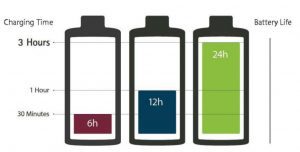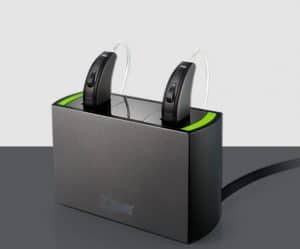Time to Read: 10 minutes
In the past decade or so, there has been some experimentation with rechargeable hearing aids. Most notably Siemens (now Signia) and GN Resound (who later stopped using these batteries). Siemens uses an older nickel-metal-hydride battery, which delivers about 8-10 hours of use per charge.
In 2017, everything started to change in regards to rechargeable hearing aids. A company called ZPower ® started gaining traction with their rechargeable Zinc-Air hearing aid battery. Phonak launched their Lithium-Ion rechargeable B-R range of hearing aids. They were quickly followed by Signia with their Lithium-Ion Cellion range of hearing aids.
Initially we had two camps of rechargeable hearing aids. One is based on Lithium-Ion, while the other was based on ZPower’s ® rechargeable Zinc-Air solution (Failed!).
Lithium-Ion hearing aid batteries:
Lithium-Ion batteries are built into the hearing aids and cannot be removed by the user. You simply put the hearing aid in the charger overnight. By doing so you receive 24 hours of use from the rechargeable hearing aid including some use while streaming. These batteries are designed to last at least 2 to 6 years, depending on brand but are replaced when the hearing aids go to the manufacturer for repair or servicing.
Pricing options differ between suppliers. Phonak & Unitron include the charger in its pricing, whereas most others don't. It’s important to make sure any quotes include the charger, as the hearing aid won’t function without it. As a rule, we quote our hearing aid prices including the charger, so there are no nasty surprises.
Lithium-Ion hearing aid batteries are controlled by a chip, so you shouldn’t have any issues with over-charging or exploding batteries. Due to the small size of the batteries, they are also safe to fly with.
Lithium Ion is available in most hearing aid brands and is even seen in some in-the-ear hearing aids
Some chargers have built-in or add on battery packs. This makes it great if you travel in places where a USB power point is not always available.
Lithium-Ion battery pros for hearing aids:
- Can deliver over 24 full hours of charge including about 5 hours of streaming on a single 3 hour charge.

- Quick charging - a quick 30 minute charge gives you 6 hours of use
- Can last all day, not matter how full your day is.
- There is generally no battery door, so the hearing aid is more moisture resistant than those with battery doors.
- Safe
- A single battery can last 5+ years - so no additional ongoing costs. - varies between models and brands.
- Very low risk of battery ingestion
Lithium-Ion Hearing aid battery cons:
- You either need a power point or a power pack to ensure you don’t end up with a dead hearing aid when travelling. (fortunately all hearing aid chargers can charge off USB)
- The Lithium-Ion battery makes the hearing aid a bit bigger than ones with a standard size 312 or 13 battery.
- The hearing might need to be sent for repair when the battery requires replacement - Some brands like Oticon allows for in-clinic replacement.
ZPower ® Silver-Zinc (A flop):
ZP ower ® is a company who had innovated by building a rechargeable silver-zinc battery solution that could be adapted to fit most suppliers’ hearing aids. The initial release was focused around size 312 batteries,
ower ® is a company who had innovated by building a rechargeable silver-zinc battery solution that could be adapted to fit most suppliers’ hearing aids. The initial release was focused around size 312 batteries,
The hearing aid manufacturer that wanted to make use of the ZPower ® rechargeable option, needed to design a battery door that fit into the ZPower ® charger. The ZPower ® rechargeable hearing aid battery then replaced the normal hearing aid battery. A charger was included and the hearing aid user simply docked the hearing aid in the charger overnight. The charger was smart enough to detect if a normal zinc-air battery was in the aid instead of the rechargeable hearing aid battery. It would simply not charge in that event.
There were several manufacturers supporting Z-Power ® as it was a very easy and affordable way to turn popular hearing aids into rechargeable versions. Many brands also offered retrofit rechargeable kits for their hearing aids. It consisted of a battery door, some rechargeable hearing aid batteries and the charger. Reliability has been poor and ZPower seems to have gone out of business, so this option is not as readily available anymore.
We have been fortunate in that our suppliers were willing to mostly swap customers stuck with ZPower driven hearing aids over to Lithium-Ion hearing aids at no charge.
Now that rechargeable hearing aids have been around for a few years, Lithium-Ion the clear winner for convenience and benefit.
More and more hearing aids with rechargeable batteries are released and the battery technology as well as the hearing aid rechargers seem to be improving in design and speed of charge. Some rechargeable hearing aids, like Phonak's Paradise range even offer hearing features that are only available in the rechargeable models.
Fuel Cell Technology
Widex currently has a fuel cell powered hearing aid going through the FDA approval process. The aid has a special methane based charger, which charges the aid in around 20 seconds. It requires no power to charge at all. It does however require special methane cartridges, which may increase the cost of this option. The cartridge then becomes a replacement for the battery cells, so I am still unclear of the true benefits, despite the impressive technology behind it.
I am not convinced this hearing aid technology will ever see the light as Widex also now offers a range of Lithium-Ion hearing aid battery options.
Call us today on 1800 157 429 o get a quote on a rechargeable hearing aid best suited to you.